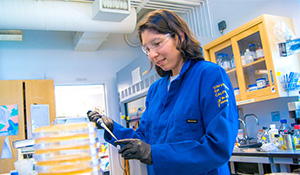
Ben Shen

Ben Shen
Position
Scripps
Website
THURSDAY I APR. 28 I 3:30-4:30 PM CST I HYBRID SEMINAR
TO JOIN REMOTELY, GO TO: Z.UMN.EDU/BTI-2022-SPRING-SEMINARS


Position
THURSDAY I APR. 28 I 3:30-4:30 PM CST I HYBRID SEMINAR
TO JOIN REMOTELY, GO TO: Z.UMN.EDU/BTI-2022-SPRING-SEMINARS


THURSDAY I APR. 14 I 3:30-4:30 PM CST I HYBRID SEMINAR
TO JOIN REMOTELY, GO TO: Z.UMN.EDU/BTI-2022-SPRING-SEMINARS
Will Harcombe
Jeff Gralnick
A postdoctoral position is immediately available in the BioTechnology Institute and Department of Medicine, Div. of Gastroenterology, at the University of Minnesota.
Mike Sadowsky and Alex Khoruts are looking for a highly motivated postdoc to work on a project related to the development of new and novel formulations of microbiota-based for a variety of human diseases. This project follows up on our encapsulation technology for intestinal microbiota transplantation in adult patients. However, an important goal is development microencapsulation to enable oral administration of live microbiota to patients who may have difficulty with capsules, e.g., young children. This postdoctoral project will help develop the technology and follow engraftment of intestinal microbiota in animal models and patients using DNA sequencing, qPCR, metagenomics and culturing methods.
All applicants must have a Ph.D. in microbiology, pharmacology, or a relevant field. Expertise in microbiology, microbial ecology, pharmacology, and analytical chemistry, is highly desired.
The position is for 2 years, and is annually renewable depending on performance and availability of funding The successful candidate will receive training in professional and personal development, research collaboration, presentation and publication of results, outreach, and mentoring. The position includes a competitive salary and health insurance. Review of applications will begin immediately and will continue until the position is filled. A near-term start date is desired.
Applications should include: (i) brief cover letter, (ii) curriculum vitae, (iii) a brief description of past research accomplishments and future research goals (under two pages), and (v) the names and contact information for three references. All materials should be submitted as a single combined PDF to Alex Khoruts (khour001@umn.edu) and Mike Sadowsky (sadowsky@umn.edu) with “Postdoc Application” in the subject line. Any questions should also be directed to these email addresses.

Facilities questions for PMB, BTI, and EEB, UCard and key requests, building emergencies, autoclave issues, space use updates, coordinating special events
Ann lives in St Paul with her husband and Boston Terrier. She enjoys connecting grad students and PIs to the solutions they need to function in their research, and she relishes the arcane details of the work going on in CBS. In her off-hours, Ann bikes the twin cities, bakes, and gardens.

Minnesota’s Iron Range is dotted with active and abandoned mining sites. Left untreated, runoff from these sites can flow into the environment and release heavy metals and organic pollutants, ultimately endangering wildlife and threatening human health.
But what if we could engineer the environment to clean itself? With support from the MnDRIVE Environment initiative, researchers in the BioTechnology Institute’s Schmidt-Dannert lab are developing Biohubs using genetically engineered proteins capable of breaking down heavy metals and removing toxins from mine drainage and other industrial sites.
Biohubs take advantage of a protein’s natural tendency to self-assemble into stable shell-like structures. Their porous surface converts harmful metals and organic pollutants into non-toxic components.
Based on similar structures found in nature, the lab’s model Biohub converts toxic mercury compounds into a form that can be released safely in the environment. The process relies on modified proteins that bind toxins while enzymes, small proteins capable of catalyzing biochemical reactions, convert mercury to its inert elemental form. The system is “self-cleaning” because the enzymes remain active inside the Biohub until it encounters the next metal, and restarts the process.
On-site, the Biohubs are placed in glass or metal columns that act as a filtration system; contaminated water enters through one end of the column and exits at the opposite end of the column free of toxins.
Using enzymes to clean the environment has advantages. They are versatile and leave no toxic residue, but enzymes found in nature are not always stable, and Schmidt-Dannert’s team needed a way to protect and stabilize the proteins. Enter Minnepura Technologies; a biotech startup co-founded by University of Minnesota Professors Alptekin Aksan and Lawrence Wackett. Minnepura specializes in the development of biocomposite materials designed to encapsulate and protect proteins. Minnepura and will encase the Biohubs in an easily adaptable, light-weight silica that supports the structure over time.
“Initial studies will focus on remediation of heavy metals from mine drainage, but the system could also be applied to clean up of pesticide-contaminated soil or water near agricultural land,” explained Maureen Quin, a lead researcher on the project.
Schmidt-Dannert believes engineered proteins hold considerable potential as a platform technology for sustainable bioremediation. “If we can get this to work with organic compounds, this solution could be very versatile and able to convert a variety of different pollutants.” In states like Minnesota trying to balance the competing demands of industry and environmental stewardship, Biohubs may help the environment clean itself.
Lauren Holly is an intern in the BioTechnology Institute’s Science Communications Training Program.